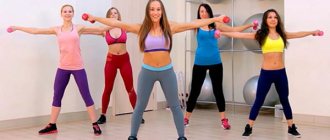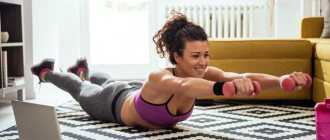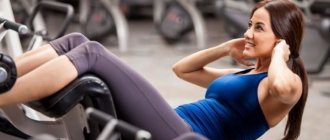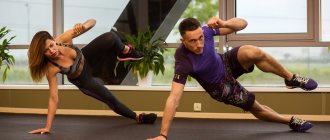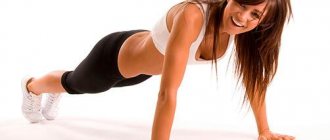This article is an introduction of sorts. It is dedicated to all those who are just about to plunge into the diverse world of fitness, to those who have finally decided to say to themselves: “I want - and I will!”, I will be as beautiful and healthy as I have always dreamed of.
It's important to take the first step. It will be much easier from now on!
So, you finally realized that the time for great achievements has come. You have nothing to lose except your complexes, you can’t put it off any longer, and it’s time to take care of yourself. You have been working towards this for a long time, but something always got in the way, you put it off, and came up with a wide variety of excuses.
But now your patience is full, your excuses are over, the mirror looks at you with silent reproach, and your beloved man runs from the kitchen to the TV, not noticing your presence.
"It's time to act!" - you said decisively to yourself. But where to start? Should you run to get a subscription to the nearest fitness club, go shopping, buy a tracksuit, or rush into the thick of the Internet in search of exercises to lose weight?
So, let's start in order. First of all, calm down, because you have already made the most important decision. Now think about what is happening.
What types of fitness include?!
In a broader sense, fitness is the general physical fitness of the human body.
This means that fitness includes a whole ensemble of training practices:
- Anaerobic training (workouts in the gym)
- aerobic training (running, cycling, swimming, dance, exercise to music and many others)
- Pilates
- yoga
- flexibility/stretching
- in short, anything...
Types of fitness
This type of physical activity has several varieties, each of which is intended for certain categories of people and solves specific sports or health goals. There are strength and gentle systems, male and female types of fitness.
Along with the above, there are the following varieties:
Aerobics
A popular fitness trend that includes dance, kick, slide and water aerobics. Exercises performed to music correct the figure, develop a sense of harmony and rhythm, and have a beneficial effect on the respiratory system.
Pilates
A set of exercises based on calm, smooth, slow movements. It does not involve high loads. Its main advantages are the absence of any contraindications to exercise and low risk of injury. Pilates classes help strengthen muscles without pumping, increase flexibility, and make joints more mobile.
Bodyflex
This system is based on the principle of proper breathing when performing all the exercises of the complex. Bodyflex is ideal for people who want to get rid of extra pounds; it helps to normalize the metabolic processes occurring in the body.
Fitball
It consists of performing a variety of exercises with a special ball. Ideal for those who want to correct their posture, improve coordination, tighten their buttocks, and strengthen their back muscles.
Taibo
A relatively new type of fitness, whose style was borrowed from boxing and Asian martial arts. Classes are held to energetic and invigorating music and require a person to expend a huge amount of energy, strength, and endurance. An hour-long training session using the Taibo system is comparable to a ten-kilometer race.
Where to start with fitness? Club coaches recommend
As I said earlier, fitness is not a sport, and the goals are different. Never forget this!
IMPORTANT: fitness training should bring you joy, positive emotions from the process.
And in order for this to happen, you need to do the type of fitness that you like, and not me or anyone else, for example. This is the first point. Which I draw your attention to.
The second point: training should meet your goals and correspond to your physical capabilities.
- These are training programs that will not harm your health.
- And such training programs that simultaneously solve your goals.
Tendon exercises with chains
The original Iron Samson system consists of exercises using chains. Triangular-shaped metal handles with hooks are attached to the chains, which, if necessary, are interconnected, lengthening or shortening the chain section. To support the legs, belt loops are attached to the ends of the chain. That is, to start practicing, you need to purchase 2 chains the length from the floor to your outstretched arm and make 2 handles for the hands and 2 loops for the legs.
Chains are sold in hardware stores. Handles can be made like this: take two pieces of pipe of a convenient thickness and thread a wire (or cable) into them, bent at the connection into a hook. Leg loops are very important, as they provide comfort for the most powerful tensions of the body (for example, in the atlas pose). Ask ladies you know about old handbags, try using tarpaulin or material for trunks. But first, experiment with the fabric: step on it with your foot and pull its ends up: evaluate the thickness, width, and comfort of the loop. You can use the loops in conjunction with slippers.
The exercises presented are collected from two articles by Yuri Shaposhnikov, nephew of Alexander Zass. Thank you.
In the initial position, the chain should be tensioned. Follow the rules of tendon gymnastics.
A set of exercises for beginners
We will now consider 3 areas:
- anaerobic training (in the gym)
- Aerobic workouts (running, swimming, cycling, elliptical and more)
- and, for example, some kind of statics, work on flexibility and stretching (yoga, stretching)
Basic recommendations before starting:
1. Before training, you need to eat 1.5 - 2 hours before training (this does not apply to aerobics)
What is? Optimal: complex carbohydrates + proteins + fiber.
For example: buckwheat (complex carbohydrates) with meat (protein) + salad (fiber).
2. Before any workout, a full, high-quality warm-up of the whole body is required.
This could be joint exercises, or walking-running on a treadmill, etc.
Purpose: to stretch the muscles, prepare ligaments and joints for exercise.
Warm-up is performed for 5 maximum 10 minutes until the forehead is covered with sweat.
3. During training and doing exercises, it is important to breathe correctly.
Under no circumstances should you hold your breath. As a rule, breathing is always EFFORT.
For example, you need to inhale through your nose (when you lower something), and exhale through your mouth (when you lift something).
4. Drink water during training, depending on how you feel. But under no circumstances should you abstain from water.
During training, water envelops the joints and penetrates the soft tissues, protecting them from injury.
In general, water has many properties, for example, lack of hydration (dehydration) will cause me fatigue, drowsiness, dizziness, and no amount of training will benefit me in such conditions.
“PravIlo” - ancient Russian simulator
The secret lies in the ability to extract additional energy not from the muscles, as is traditionally done (in the fitness room, strength exercises, jogging, swimming, etc.), but from the bones, ligaments and tendons - an unaccounted source and reservoir of physical and vital force , unexhausted and unclaimed in modern life.
By gradually stimulating bone tissue and, especially, bone marrow, which accumulates solar energy in large quantities, a person learns to release this energy, including coordinated image, breathing and movement in the stretching process. (By “image” we mean the ability, during exercise, to mentally cover with attention the reference points in the body, equidistant from the center, located in the solar plexus.)
In addition, as a result of horizontal traction on the simulator, the human spine is unloaded in a way that is not achieved in an ordinary hang on a bar. Pathological clamps (fixations of tension in the body), formed throughout life, are weak links in the entire chain of processes taking place in the body. Their complete removal is possible in different ways. One of the most effective, in my opinion (based on my five years of experience with corrections on this simulator), is horizontal traction, where the load is evenly distributed during tension and relaxation, producing compression and expansion of the musculoskeletal system like inhalation and exhalation.
This also entails improved posture, increased body tone, making the skin smoother and more elastic, walking easier, contributing to the influx of additional reserve forces and prolonging life.
Volodarsky B.I. about the "rule"
Boris Ivanovich, where are you from?
— I come from Karelian Pomerania, Tver (Kalinin) region. Where did the gift of healing come to you?
- From living on your own land (not in the city): from working on it, from food grown on it with your own hands, from pets. From the Ancestral Power, inherited from the grandmother. From life experience and knowledge. What methods do you use?
— My healing system includes the use of natural elements - earth, water, air, fire, solar energy. I use special exercises, as well as stretching on the rule (emphasis on the “and”) and casting with beeswax. The most important thing is for the patient to believe in his own inner strength, that there are no incurable diseases and that at any age you can start a new life. The very word “treatment” is criminal, not treatment, but liberation from the disease.
What is a rule?
— Pravilo is an ancient Russian simulator for correcting a person in the process of life, for him to gain strength and endurance. Stretching on the rule returns a person to the “original” state, relieving tension in the body that has accumulated during life. How do you feel about psychics?
— Without a kind, energetically compatible, equally-minded wife, as well as natural living conditions, there is no Russian healer, but there are psychics generated by dark forces. Therefore, the attitude towards psychics is negative. A huge number of psychics and different “schools” are the result of anti-Russian perestroika. I always say: “If you are a Slav, a Russian, then drink milk only from a Russian cow!”
Do you have the gift of foresight?
— Knowing in advance is a great power, my parents told me this, and this gift is present and develops throughout life in every normal healthy Russian person. The gift of foresight for me is a premonition, intuition, and extensive life experience. If a situation requires a quick resolution, then foresight is expressed in the form of warning signs. If you need a detailed answer to a question, then in the morning, at dawn, the answers always come. What is the root of the disease, and how should a person live in order not to get sick?
— The root of the disease is in our consciousness, which forms our unhealthy lifestyle, which, in turn, leads a person to disease. It's never too late to start a new life according to the laws of Nature and Space, which include a whole system of human behavior that allows you to strengthen, and not destroy, your family, your Family. Andrey Polyakov
Setting up a house rule
Details for the rules:
Winch - 1600 (available inexpensively in special stores with equipment for service stations) Slings 4 meters - 200 Washers 12 pcs - 30 Elastic bandage 3m - 50 (you can without it, cut off the sleeves from an old sweater) Cable 2mm x 15m (you could have taken less 2 times) - 100 Rivets for the cable 4 pcs - 10 Block rollers 5 pcs - 1090 Chain 0.5m x 2 - 100 (cut right in the store) Screw anchor-hooks 5 pcs - 100 Screw anchor-bolts for attaching the winch 3 pcs -60 Carabiners 9 pcs (you could take 7) - 230
Total = 3570 rubles.
Some photos are correct.
spare parts:
This is how the leg is attached:
This is what the cockpit looks like:
https://www.seorp.ru/ Tendon exercises by Zass (Iron Samson)
“Some people with thin legs are stronger than people with thick legs - Why? Because the power lies in the tendons, in those invisible hard tissues that are second in density only to bones. Without tendons, a person would turn into jelly. But the tendons need to be trained. From my experience, one can be convinced that a large man does not necessarily have to be strong, but a man of modest build does not have to be weak.
I don't believe in big muscles unless there's real big tendon power next to them. You can see physical fitness enthusiasts who have quite large muscles. But what good are they if there is no powerful foundation - developed tendons. They are unable to fully utilize the strength of their muscles during an actual test of strength. And therefore their power is only an illusion.
Tendons increase their strength best when their power is applied to some almost immovable object. They become stronger from resistance than from movement.”
Alexander Zass, or Iron Samson, created an ingenious system for developing strength.
Here the supporting part of his system is presented: the development of tendon strength.
“I never strived for big muscles, believing that the main thing was strong tendons, willpower and the ability to control my muscles. When I started performing in the circus as an athlete, my biceps were only 38 centimeters. But the public needs a look, and I had to increase them to 42 centimeters through exercises with dumbbells and self-resistance exercises” (from a letter to Yuri Shaposhnikov).
“Big biceps are not a sign of strength any more than a big belly is a sign of good digestion.”
Alexander Zass achieved phenomenal strength density with the help of tendon exercises. Short, weighing 66 kg, at the beginning of his wrestling and athletic career, he caused confusion among spectators with his exploits: he defeated huge opponents, broke chains and horseshoes, tied metal rods with a bow, restrained horses rushing in different directions... Because of this confusion, Zass had to gain more weight muscle mass to rid viewers of suspicions of deception. However: throughout his entire circus career, his weight never exceeded 80 kg.
Tendon exercises have been generally known since ancient times. People's strongmen lifted and carried huge stones and large animals, practiced bending and unbending metal rods and horseshoes, dragged tree-boats-carts behind them, restrained rushing bulls and horses... In ancient Rome, athletes dressed in iron robes weighing 200-300- 400 kg and so climbed onto the platform...
But it was Zass who was the first to be lucky enough to recognize the system in the phenomenon and present it to the world. This happened in 1924.
“We need to develop what underlies the muscle, especially the tendon, not the volume of the muscle.”
In the early 60s, naive Americans rediscovered the Sass effect, calling these exercises isometric and static. Since then, tendon exercises have become part of active sports practice: to develop strength, to overcome dead spots, to form new trajectories of power movements. But here they remain separate, isolated exercises. But the system already exists!
Alas. Authorities in sports and science prefer to keep this fact in the shadows and, as a result, are forced to fool ordinary people. After all, the tendon system is phenomenal in many ways: it can be practiced with a minimum of space, equipment, and time and with excellent effect. It is no coincidence that the circus strongmen of our time - Gennady Ivanov and Ivan Shutov - used the Zass system as the basis for the development of strength.
That's why experts have to look for sunspots. They will announce that isometric straining is harmful to the heart, blood vessels, and nerves, especially those who are unprepared, such as young people or amateurs (this is not true); then they will tell you how dynamic training (complex!) surpassed isometric training (simple!); then they will remember about potentially all kinds of micro and larger tears in muscle tissue and other irreparable dangers of maximum strain.
Another way: mix concepts. They say this is the same as Anokhin’s volitional gymnastics. Here's a good home isometric complex without projectiles. Only 4-6 seconds and only after a year you can increase the voltage time to 8 seconds. And 12 seconds or more is a direct threat to health. Listen to yourself: if you get a headache, quit this disastrous business immediately. Stress only while inhaling. Train for no more than 15 minutes!
The usual thing is the opposite. The real blemish is the recent history of isometrics. In the early 60s, Bob Hoffman organized the release of miraculous power racks for isometric exercises and in his magazine “Strength and Health” he touted with all his might the cool achievements of Bill March and Louis Riquet, who added several hundred pounds to their all-around competition in six months. Many have made decent progress, but no one has been able to repeat the fantastic breakthrough of March and Rike. And finally it turned out that there was another reason for their rise - steroids. The scandal simultaneously and permanently damaged the reputation of isometrics.
Nevertheless: this was the first large-scale experiment. Equipment was plentiful, and a few years later a scientific study of 175 athletes doing isometrics showed an average weekly 5% increase in strength. Wow!
It was at this time that isometrics became firmly established in world-class sports practice, but at the same time remained narrowly focused, boring and far from ordinary amateurs.
But how simple it could be: if you reissue 2 original books by Alexander Zass + the book “The Amazing Zass” of 1925, if you show how exactly chain voltages act - on themselves and in the system, if you still take into account new experience “in favor” of the system Zassa.
In the meantime, let’s answer objections and confusion:
• The Zass system also includes dynamic exercises with a bag. And apparently the newest revelations of the Gurias of bodybuilding are slowly approaching the Zass system. On the other hand, progress is an objective thing and they also have something to improve - to update the Zass system.
• Complex tendon training includes not only statics, but also “pumping” of the entire joint volume by tension. That is, the development of the tendon spring, the development of the connection of the tendons with the joint and with the muscle, the distribution of the tendon force density over the entire motor range of motion, the development of accompanying balances-regulations-controls. And it’s natural to use different modes of tendon training: for example, stops, carrying weights, standing like a “pillar” or “rider” or just like that, holding a barbell with your body... warming up, mobilizing, maximum...
• The danger of straining for health is directly related to disturbances in energy and physiological regimes: first of all, nervous and improper breathing, then a disruption of the processes of prompt and long-term recovery, and finally, this is a practice of narrow-private use leading to distortions in the overall energy exchange. All these syndromes can be reproduced without isometrics - in any activity, and even more so in sports.
• Gymnastics Anokhina lives next door and some of her exercises can very well complement tendon gymnastics. But!! — volitional gymnastics is muscular gymnastics. Its closest relatives are Hermes gymnastics, hatha yoga, and stretching.
• However, a direct close relative did appear. This is Vladimir Fokhtin’s autonomous gymnastics, self-resistance gymnastics. She, too, has a hard time with experts: they will either declare her to be Anokhin’s gymnastics, or describe her usefulness as tasks for toning up ordinary people or as a temporary means for business trips, or remember the dangers of isometric exercises. Indeed: Fokhtin’s gymnastics develops tendons, develops joints, develops muscles. At the same time, it requires a minimum of space and absolutely no shells. True, the author followed the lead of the experts and somewhat overcomplicated the starting course to 88!!! exercises. It's not even a matter of quantity - it's a complete system, the problem is the structure of the delivery of these exercises. Plus, the author carefully distanced his gymnastics from isometrics and self-exertion. But in fact, Fokhtin took the next step in the development of athleticism and tendon gymnastics.
• About the 6-second mode, in which the maximum force is 2-3 seconds. Unfortunately, I don’t know Zass’s own opinion about this.
But here's what we know:
a) Zass in prison practiced 15-20 second tensions, therefore, under normal conditions and with normal nutrition, he could use minute tensions. b) In the first 6-8 seconds, the ATP reserve is burned, then glycogen comes into play and fat is ignited at 40 seconds. The problem is that the isometric way of expending and restoring energy conflicts with the aerobic dynamic way. In general, if you don’t change anything, then you really have to choose “either or”. If you choose isometrics, then naturally 4 modes of tension are revealed: 6 seconds, 15-20 seconds, 1 minute, 3-6 minutes. But they still need to be awakened, treated, developed... Otherwise, it is very easy to overtrain and fall into a viscous pit of distress.
The tendon system of developing strength using chains is original and fresh to this day. The Zass system allows you to quickly increase strength, strengthens ligaments and tendons, creating a foundation for the natural development of muscles.
Note for women: proper performance of tendon exercises does not increase muscle volume, does not enlarge veins, includes subcutaneous fat in the overall energy exchange (promotes resorption and improvement of the skin), improves character and the ability to stand up for oneself. True, you will have to show taste and ingenuity in selecting exercises.
Tendon exercises can be performed using different equipment - a metal rod, chains, a thick cord, a wooden stick. You can use furniture, walls, doorways. Try to bend a thick metal rod or break a chain, squeeze a stick, lift a door frame: muscles and tendons tense, the whole body is involved in a ringing force wave, ripens to maximum density... and smoothly returns back to peace. By repeating these tests several times, we develop and strengthen the force wave and, with it, the strength of the entire body.
Rules for tendon gymnastics
• your object is your body, so don’t break the chain - just create a dense body wave, the chain will break itself • breathe calmly, without straining your breath when making an effort, exercise against the background of calm breathing • the power wave should cover the entire body, from the soles to the working implement ; at the same time, as if pressing your body into the force - this will increase the volume of the muscle-tendon-joint connection • the wave should be good: smooth-elastic entry, strengthening without breaks to a fairly maximum density, smooth-calm exit • develop the natural strength of good nature: minus nerves , minus the result, minus the breathing, plus a volumetric body wave - this way you will avoid all the “dangers”, including headaches and protruding veins • strained the force - let go, listen to the restoration of strength with gain; gain is new energy, you have nothing to realize it with, so we focus on recovery + the feeling of uncertainty that accompanies the arrival of strength • perform the exercise 1-5 times with standard pauses from 30 to 90 seconds; with more powerful efforts, you may need longer pauses from 3-5 to 10 minutes (experiment) • if the breathing deepens, the heart is pounding, the force wave breaks or shows bodily discomfort - then you need to stop and calm down, reduce the effort, massage - feel the discomfort with a gentle wave • do not rush, let the total duration, magnitude of effort and duration of the maximum develop naturally; start with short 2-5 second tensions, and enter longer ones more gradually • in a tonic-daily mode, select 5-8 favorite exercises and perform them in 1-3 tensions with an effort of 60-90-75% (approximately) • full strength training should be performed no more than 2 times a week and take no more than an hour; here, for 5 repetitions, you can focus on the following efforts - 75-90-95-90-75% of the satisfied maximum • daily stress is best combined with the mindset for the day or task, strength training is best tuned to the image of the week or goal
Once a week, at the end of a strength training session, I advise you to perform a tonic test: a minute stretch of a stick-chain-towel, with your arms down, with an effort of 95%. After stretching, listen to your hands: if the muscles are healthy, then the hands will rise to the sides and up and hover there for a while (on the side or at the top). The amount of this time - the amount of tonic activity - will indicate to you your weekly progress not only in strength, but also in its quality. If there is no progress, then it means you are doing something wrong: you are not getting enough sleep, you are overeating, you are worried, you are burnt out in business, you have not had time to recover from the previous workout, you have pushed yourself too far in this workout. If your tonic activity is less than a minute, be doubly careful with overexertion. If your tonic activity is above 1.5 minutes, then you can be congratulated: you are doing everything correctly and quality progress in strength is guaranteed to you.
Anaerobic training at home
You can train calmly and at home, without any sports equipment.
If there is a desire, there will always be opportunities.
Here's what an anaerobic training program for men might look like:
- Squats 6x15-20
- Lunges 3x15-20
- Push-ups 6x15-20
- Reverse push-ups 6x15-20
- Press crunches + reverse crunches 5x15-20
- Training exercise Plank 3xMAX
For clarity, I will show each of the exercises + provide links to their detailed study.
- squats
More details about this exercise in the main article: “Squats from A to Z.”
- Lunges
- pushups
More details in the main article: “How to do push-ups correctly.”
- reverse push-ups for triceps
More details about this exercise in the main article: “Reverse push-ups exercises.”
- Ab exercises (lying crunches/reverse crunches)
Learn more about “Lying Crunches” and “Reverse Crunches.”
- plank exercise
Here's what an anaerobic training program for girls/women might look like:
- Sumo squats 3x15-20
- Lunges 3x15-20
- Pelvic lift lying on the floor 3x15-20
- Leg abduction while standing on all fours 3x15-20
- Push-ups 3x15-20
- Press crunches + reverse crunches 3x15-20
- Exercise Plank 3xMAX
For clarity, I will show each of the exercises + provide links to their detailed study:
- sumo squats
All the details of this exercise are in the main article: “Squats for the buttocks.”
- lunges
Read more in the main article: “Lunges for the buttocks.”
- pelvic lift while lying on the floor
More details from A to Z about this exercise in the main article: “Lying pelvic lift.”
- leg abduction on all fours
More details about this exercise in the main article: “Leg abduction while standing on all fours.”
- push-ups from the floor (can be done from the knees)
More details in the main article: “How to properly do push-ups from the floor”, “Push-ups from the knees”.
- plank exercise
More details in the main article: “Planck exercise.”
- Ab exercises (lying crunches/reverse crunches)
Learn more about “Lying Crunches” and “Reverse Crunches.”
How often to train according to these schemes? 3 times a week of anaerobic training will be a head start.
For example, Mon, Wed, Fri or Tue, Thu, Sat (whichever is more convenient for you).
Rest between approaches: depending on how you feel until breathing and strength are completely restored.
Duration of strength training: 45-60 minutes.
What weights to work with: only light weights (relatively speaking), our goal is health, not achieving high athletic results = therefore the load should not be excessive, it should be sufficient, without bullying), we do not increase weight, that is, we do not we use the principle of load progression;
Each set of each exercise should be completed with ease (without exhaustion, pain, heaviness, etc.);
Number of approaches: a large number of repetitions, to acidify the muscles (from 10 to 20);
Goal: feel good during and after training;
How to behave
Put the equipment back in place
garagegymbuilder.com
This is one of the signs of good form: disassemble the barbell and return all the plates to their place, put the dumbbells on the rack, put away the yoga mat.
If everyone throws the equipment where they finished exercising, it will take a long time to search around the gym for the necessary dumbbells or jump rope.
Therefore, in order not to increase the chaos and not to catch the indignant glances of others, put everything that you took for training back in its place.
Exercise in the right area
Gyms are divided into zones that are the same in almost all establishments:
- cardio zone, where there is a treadmill, exercise bike, ellipse;
- area for exercise with free weights - next to the rack with dumbbells;
- area for stretching and relaxation - there are massage rollers and balls, mats, expanders;
- a platform where weightlifting exercises are performed;
- areas for group classes - as a rule, these are separate rooms with mirrors.
Try to perform exercises in areas that are designed for this. If you sit and stretch in an area where people are lifting dumbbells, you'll be in their way and look weird.
Share equipment
If a person is waiting for a machine or dumbbells that you work out with, you can invite him to do the exercise in between your approaches while you rest. This is normal practice, especially during peak hours when the gyms are constantly busy.
Don't leave puddles of sweat behind
When a puddle of sweat remains on the bench from the last person, it’s just awfully disgusting. So if you sweat a lot, always put a towel on the bench or at least wipe the sweat off after yourself - many gyms have wipes.
Always wash your clothes after training
Smelling good can be considered a rule of gym etiquette, but despite modern hygiene products, there are always those who break this rule.
If you wear clothes to workout, throw them in the washing machine as soon as you get home—no matter how intense the workout was, whether you sweated a lot or “just a little.”
By the way, this is another reason to buy normal sportswear: unlike cotton T-shirts and shorts, they do not fade or stretch due to frequent washing.
That's all. Do not violate the rules of good manners, be polite and do not hesitate to ask athletes and coaches how to exercise on exercise machines, where to get the necessary equipment and whether you are performing any exercises correctly - many will be happy to help you.
Aerobic training: debriefing
When to conduct this type of training:
- in the morning on an empty stomach
- after strength training
- in the evening before bed (if there were no carbohydrates in the evening).
The choice of interval is based on your own considerations.
Why these particular time periods?
During these intervals, the body contains either a minimum of ENERGY or none at all = this allows you to purposefully burn fat to the maximum, thereby we not only train our body, muscles, heart, but also burn fat along the way, but this works primarily with the right diet for weight loss.
Training frequency: optimally 2 times a week on days when there is no aerobic training.
Duration of training: depends on the level, at the initial stage you can even start with 10-15 minutes (if it’s difficult), then depending on how you feel, it will be optimal for 30-45 minutes.
Goal: feel good during and after training;
When will the results be available?
Perhaps this is the most pressing question that concerns not only beginner fitness enthusiasts, but also experienced athletes. The only difference is that athletes know what this very result depends on, and they know how to predict it. Precisely to predict with some degree of probability. Because even professionals cannot predict one hundred percent the exact time for the appearance of the result.
First, let’s define what this very result is? For some, it’s losing a few kilograms of weight or the appearance of the treasured six-pack on their stomach, and for others, it’s a gold medal at international competitions. Good health, flexibility, energy and joint mobility are also significant results.
And, of course, it should be understood that the result is always the sum of factors. Unfortunately, many people forget about this. The result depends on the scale of the goal, on your initial data (physical condition, age, physique, lifestyle), on the correctness of the chosen training, and of course, first of all, on your desire.
Decide what result you want to get and follow your goal.
You will see the very first result, expressed in an improvement in your well-being and mood, after just a few workouts. So stop counting the days, just have fun, and know that the result will definitely come. The main thing is to be honest with yourself (after all, you are doing this primarily for yourself).
Muscle and Energy Recovery
For results to accumulate, it is necessary to allow the body to recover. To do this, training is carried out with rest days. And for this reason, I recommend not doing every workout to failure. A quick recovery is facilitated by: adequate sleep at night, a dense and nutritious diet, sports nutrition (in accordance with the training program), and taking care of your health.
Muscle recovery after training. How much time do you need?
